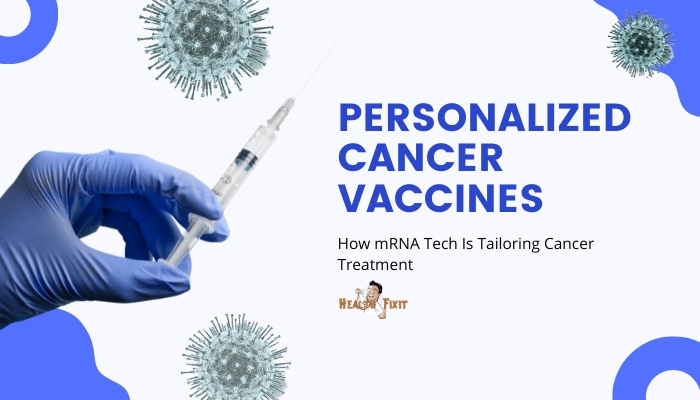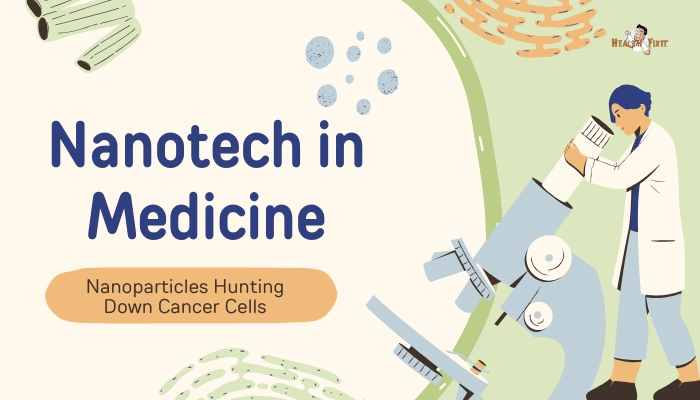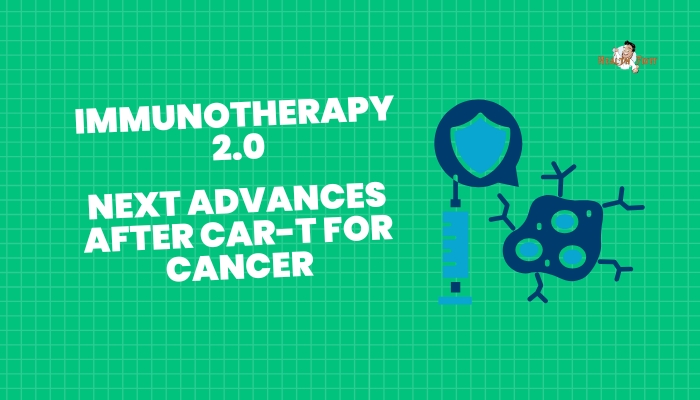Introduction
Cancer is not a single disease but a broad category of disorders in which abnormal cells proliferate. Although the immune system can detect and eliminate many abnormal cells, cancer cells can adapt to evade immune responses.
Researchers have developed strategies to boost the immune system’s natural defenses, resulting in what is often referred to as cancer immunotherapy.
ne rapidly advancing area within immunotherapy is the concept of personalized cancer vaccines, especially those built on messenger RNA (mRNA) technology.
mRNA vaccines have gained public attention through their use in certain infectious disease vaccines. However, this same technology shows promise in oncology.
By designing vaccines that reflect the unique molecular features of an individual’s tumor, scientists hope to trigger an immune response specifically directed at cancer cells.
Such an approach may limit unintended side effects while providing potent defense. In this article, we explore the science behind mRNA vaccines for cancer, their benefits and limitations, and how they may shape the future of oncology.
Understanding Cancer Immunotherapy
Cancer immunotherapy enhances the body’s ability to fight cancer. Traditional therapies—such as surgery, chemotherapy, and radiation—aim to reduce tumor mass. Immunotherapy pursues a different approach: guiding the immune system to recognize and attack malignant cells. It includes various methods:
- Checkpoint Inhibitors: Block proteins that cancer cells use to avoid immune responses.
- Adoptive Cell Transfer (ACT): Laboratory-modified T cells that target tumor antigens.
- Therapeutic Vaccines: Stimulate the immune system to generate a sustained response against tumors.
Why Vaccines in Cancer?
Vaccines have prevented infectious diseases for decades. They typically use an inactivated or weakened pathogen (or components of the pathogen) to prepare the immune system for real infections. A cancer vaccine works similarly but focuses on antigens produced by cancer cells. If the vaccine prompts a strong immune memory, the body can respond quickly and effectively against tumor cells that display those antigens.
However, cancer cells present a challenge. They arise from the body’s own tissue, making them harder to identify as harmful. Additionally, each tumor has unique molecular features, which is why a one-size-fits-all vaccine may be less effective for many cancer types. This variability creates an opportunity for personalized or patient-specific vaccines.
Basics of mRNA Technology
The central dogma of molecular biology describes how DNA is transcribed into RNA, which then translates into proteins. Messenger RNA carries the genetic code from DNA to ribosomes, where proteins are assembled.
Key Features of mRNA Vaccines
- Direct Protein Synthesis Instruction: mRNA vaccines carry the instructions for cells to produce a specific protein or peptide. In the context of cancer vaccines, this protein often resembles tumor antigens.
- No Risk of Infection: Unlike certain live vaccines for infectious diseases, mRNA vaccines do not contain any live pathogen. They only provide a “blueprint” for the antigen.
- Rapid Development and Adaptation: The design and production process for mRNA can be quicker compared to traditional protein-based methods. Manufacturers can adjust the mRNA sequence if new tumor antigens or variants emerge.
- Natural Degradation: mRNA is relatively short-lived in the body. It degrades after instructing cells to produce the target protein, reducing the risk of long-term complications.
Delivery Methods
mRNA vaccines often require delivery techniques that protect them from enzymes in the bloodstream. Lipid nanoparticles (LNPs) are commonly used carriers. These tiny, fatty particles encase the mRNA, shielding it until it reaches the cells. After entry, the mRNA is released into the cytoplasm where ribosomes read the genetic message and produce the intended protein.
How Personalized mRNA Cancer Vaccines Work
Standard cancer vaccines often focus on common antigens found in many patients with the same cancer type. In contrast, personalized mRNA vaccines rely on a detailed analysis of an individual’s tumor. Researchers can identify unique neoantigens, which are proteins that form due to tumor-specific mutations.
Steps in Developing a Personalized mRNA Cancer Vaccine
- Tumor Sample Collection: Surgeons or interventional radiologists gather a sample of the patient’s tumor.
- Genetic Sequencing: Scientists perform genomic and transcriptomic analyses to detect mutations and abnormal protein expressions in the tumor cells.
- Neoantigen Selection: Software tools predict which mutated proteins can serve as immunogenic targets. These mutant peptides are often referred to as neoantigens because they are unique to cancer cells.
- mRNA Design: Researchers design an mRNA sequence that codes for one or more of these neoantigens.
- Vaccine Formulation: The mRNA is encapsulated into nanoparticles, then prepared as an injectable vaccine.
- Administration and Immune Activation: The vaccine is injected. Cells at the injection site take up the mRNA, produce the encoded neoantigens, and display them on their surfaces. This presentation encourages T cells to recognize and attack tumor cells carrying similar antigens.
By centering on mutations unique to each person’s tumor, these vaccines minimize harm to healthy tissue. In principle, this method can provide a potent immune response specifically against the cancer.
Potential Advantages Over Conventional Therapies
Personalized mRNA vaccines differ from chemotherapy, radiation, or general immunotherapy in several ways:
- Specificity: They target antigens derived from a person’s own tumor, reducing damage to non-cancer cells.
- Efficiency in Production: Designing a new mRNA sequence can be faster than developing and purifying entire proteins.
- Flexibility: If a patient’s tumor mutates over time, researchers can update the mRNA design for booster shots or subsequent vaccine iterations.
- Possible Synergy: Personalized vaccines can be integrated with other treatments, such as checkpoint inhibitors or targeted therapies, potentially amplifying the overall effect.
Reduced Side Effects
Many cancer drugs cause side effects related to systemic toxicity. In contrast, a personalized mRNA vaccine may generate fewer off-target complications. Common vaccine reactions, such as injection site discomfort, fatigue, or fever, are generally mild. Although severe immune responses can still occur in rare cases, the specificity of the approach aims to mitigate this risk.
Long-Lasting Immunity
If the vaccine successfully induces robust T-cell responses, those immune cells can patrol the body and eliminate stray cancer cells. This continuous surveillance may lower the risk of relapse, although long-term confirmation is still under investigation.
Challenges and Limitations
Personalized mRNA vaccines face practical and clinical hurdles:
- Complex Production Pipeline: Each patient requires an individualized manufacturing process. Laboratories must handle biopsy samples, sequence tumor DNA/RNA, design customized mRNA constructs, and produce the vaccine under strict quality standards.
- Cost and Time Constraints: Individualized approaches can be expensive. Large-scale clinical trials and improved manufacturing methods are necessary to lower costs.
- Tumor Heterogeneity: A single tumor can consist of multiple subclones with varied mutations. A vaccine that targets one set of neoantigens may miss other active clones.
- Immune Escape Mechanisms: Cancer cells can downregulate proteins that present antigens or modify other factors to avoid an immune attack. This can limit the vaccine’s effectiveness.
- Regulatory Approval Pathways: Personalized therapies do not fit the standard drug evaluation model, which often assumes uniform production and identical content for all patients. Regulators must adapt policies to accommodate individualized treatments.
Despite these challenges, improvements in genomic analysis, manufacturing workflows, and clinical trial design have advanced the field. Researchers have already conducted early-stage trials that show feasibility and favorable safety profiles.
Role of Neoantigens in Personalization
Neoantigens are key to individualized cancer vaccines. They are formed by tumor-specific mutations. Because these mutations occur only in cancer cells, they can create new peptide sequences not found elsewhere in the body. This exclusivity can help the immune system differentiate cancer cells from normal tissue.
Predicting Neoantigens
Identifying which mutations give rise to viable neoantigens requires computational tools. Researchers look for peptides that bind strongly to the patient’s major histocompatibility complex (MHC) molecules. MHC proteins display these peptides on cell surfaces. T cells then scan them to decide which cells should be destroyed.
- Binding Affinity Models: Predict if a given peptide can attach to MHC.
- Immunogenicity Scores: Estimate how likely a peptide is to trigger T cells.
- Experimental Validation: In some studies, scientists synthesize candidate peptides, then test them in lab assays to confirm if T cells respond.
Improving Neoantigen Identification
Tumors can harbor dozens or even hundreds of mutations, but only a fraction produce immunologically relevant peptides. Accuracy matters because producing an mRNA vaccine that codes for non-immunogenic targets wastes resources. Researchers aim to refine algorithms for better predictions. Some efforts integrate transcriptomics to confirm that mutations are actually expressed at the protein level. Others use machine learning to sift through data on T-cell receptor (TCR) interactions, discovering patterns of strong immunogenic responses.
Clinical Trials: Early Evidence of Success
Several groups have explored personalized mRNA cancer vaccines in early-phase clinical trials. Although outcomes vary, initial data indicate encouraging safety and immune responses.
Melanoma Trials
Melanoma has been a favored testing ground because it frequently contains numerous mutations. In one trial, participants received a vaccine customized to their tumor’s neoantigens. Results suggested that a majority developed robust T-cell responses, and some observed a delay in disease progression. This indicates that such personalized approaches can elicit strong immunologic activity against solid tumors.
Trials in Other Cancer Types
Researchers have also tested personalized mRNA vaccines in ovarian, lung, and colorectal cancers. In many cases, the vaccine was combined with a checkpoint inhibitor. This combination approach leverages the potential synergy between an activated immune system and the removal of immunosuppressive signals that cancer cells often exploit.
Although these are preliminary findings, they highlight that mRNA vaccines can be delivered in a practical setting. Larger studies are underway to verify efficacy, measure long-term survival benefits, and examine how best to integrate personalized vaccines into standard treatment protocols.
Combining mRNA Vaccines with Other Therapies
Cancer rarely yields to a single treatment. A combination strategy often ensures a more complete attack on tumor cells. mRNA vaccines can be paired with:
- Surgery: Vaccines can target residual cells that remain after tumor removal.
- Checkpoint Inhibitors: Removing inhibitory signals can boost the impact of vaccine-induced T cells.
- Targeted Therapies: Drugs that block pathways essential to cancer cell survival.
- Radiation: Radiation can cause cancer cells to release antigens, aiding immune recognition.
Checkpoint Inhibitors and Vaccines: A Powerful Duo
Immune checkpoints (like PD-1, CTLA-4) help regulate immune activity. Tumor cells often exploit these checkpoints to dampen T-cell attacks. Antibody drugs that block these checkpoints free T cells to work more aggressively. When combined with an mRNA vaccine, the T cells that expand in response to tumor antigens can maintain their activity without being shut down prematurely.
Timing and Sequencing
The order in which therapies are given can influence their effectiveness. One approach is to administer the vaccine first so that T cells receive a “primer” on tumor antigens. Then, a checkpoint inhibitor can enhance T-cell persistence and activity. Ongoing trials test multiple combinations and sequences to establish optimal strategies.
Manufacturing and Delivery Advances
A major challenge in personalized cancer vaccines is the complex production pipeline. However, recent innovations have streamlined processes, making custom vaccines more practical.
Automation in Vaccine Production
- High-Throughput Sequencing: Rapidly and affordably identifies tumor mutations.
- Automated mRNA Synthesis Systems: Convert genetic sequences into mRNA at scale with minimal human intervention.
- Quality Control: Robotic systems can analyze mRNA quality, ensuring consistent purity and potency.
Advanced Delivery Technologies
Although lipid nanoparticles (LNPs) are widely used, researchers continue to enhance these carriers:
- Ionizable Lipids: Change charge depending on pH, helping mRNA evade degradation while in circulation.
- Polymeric Carriers: Specialized polymers can respond to triggers in the tumor microenvironment.
- Virus-Like Particles (VLPs): Pack mRNA inside a shell that mimics a virus, boosting immune detection without posing infection risks.
These developments may reduce costs, shorten production times, and improve efficacy by ensuring more precise delivery into the correct immune cells.
Timeline and Regulatory Considerations
Since each personalized vaccine is unique, regulatory frameworks must adapt. Traditional drug approvals rely on showing safety and effectiveness in a large group. But with individualized treatments, each “batch” may involve unique molecular content.
Adaptive Clinical Trial Designs
Adaptive trials allow researchers to modify study parameters (e.g., dosage, patient selection criteria) based on interim data. These designs can accelerate the discovery of effective vaccine formulations while maintaining strict safety standards.
Potential Paths to Approval
- Personalized Product Platforms: Regulators might approve the overall process by which vaccines are designed and manufactured, rather than approving each individualized vaccine separately.
- Post-Marketing Surveillance: Ongoing monitoring could track rare side effects or manufacturing variations.
- Regulatory Partnerships: Collaboration between scientists, industry leaders, and government agencies can streamline processes for personalized therapies.
Agencies such as the United States Food and Drug Administration (FDA) and the European Medicines Agency (EMA) have begun to release guidelines specifically addressing personalized medicine, indicating an evolving regulatory environment.
Cost and Accessibility
Personalized mRNA vaccines involve several cost drivers:
- Advanced Genomic Testing: High-depth sequencing of a patient’s tumor and normal tissues.
- Custom Vaccine Production: Producing small, individualized batches with strict quality checks.
- Logistics and Coordination: Seamless communication among surgeons, pathologists, geneticists, and manufacturing teams.
Strategies for Cost Reduction
- Automation and Standardized Protocols: Reducing manual steps and using uniform production methods can lower expenses.
- Scaling Up Infrastructure: Centralizing manufacturing in specialized facilities may bring down per-vaccine costs.
- Health Insurance and Funding: Insurance coverage or public funding could help patients afford these personalized therapies, especially once safety and efficacy reach clear benchmarks.
The possibility that mRNA vaccines might prevent cancer recurrence or reduce the need for long courses of chemotherapy could provide economic benefits. However, more data are required to confirm cost-effectiveness on a broad scale.
Ethical and Social Implications
With any advanced medical technology, ethical questions arise:
- Equitable Access: Ensuring that new treatments are accessible to diverse socioeconomic groups, not just a privileged minority.
- Informed Consent: Comprehensive patient understanding of a personalized therapy’s purpose, risks, benefits, and unproven areas.
- Genomic Privacy: Detailed sequencing of a person’s tumor and normal cells can reveal sensitive information about their DNA. Strong data protection policies are needed to maintain confidentiality.
If personalized mRNA vaccines prove both safe and effective, there may be a surge of public demand. Managing expectations and clarifying realistic outcomes will be critical. Not all cancers respond similarly, and many patients may need combination therapies despite personalization.
Special Populations and Considerations
Pediatric Patients
Children with cancer often have fewer mutations compared to adult cancers. This might affect the feasibility of generating potent neoantigens. Nonetheless, certain pediatric tumors exhibit unique molecular signatures that can be targeted. Researchers are evaluating personalized vaccines in some rare childhood cancers, though the approach is still new.
Elderly Individuals
Older adults may have a diminished immune system (immunosenescence). Personalized mRNA vaccines must overcome reduced T-cell functionality. Adjuvants or specific formulations might compensate by further stimulating immune cells. Studies explore whether different dosing strategies can enhance responses in older age groups.
Immunocompromised Patients
People with weakened immune systems might benefit from a vaccine that helps them fight cancer, but they could also face higher risks of side effects. Dose adjustments or supportive therapies could maintain safety. Researchers must carefully balance the potential advantages of a personalized vaccine with the need to avoid severe complications.
Future Directions
mRNA vaccine technology is evolving rapidly. The knowledge gained from large-scale infectious disease vaccination campaigns has accelerated innovation. Additionally, scientists keep exploring new ways to refine and expand the potential of personalized cancer vaccines.
- Multi-Target Vaccines: Instead of encoding a single antigen, researchers can pack multiple neoantigens into one vaccine to broaden immune responses against a range of tumor mutations.
- Combination with Epigenetic Therapies: Epigenetic drugs can unmask hidden antigens by reactivating silenced genes. This could increase the pool of targets for mRNA vaccines.
- Integration of Artificial Intelligence: AI can identify patterns in large genomic datasets, improving neoantigen prediction accuracy.
- Oncolytic Viruses + mRNA: Using modified viruses that infect tumor cells, combined with mRNA sequences that amplify immune recognition. This multi-layered strategy may lead to more effective tumor eradication.
As more data accumulates, researchers can refine which subsets of patients are most likely to benefit. Trials can expand beyond metastatic cancers to earlier disease stages, potentially stopping tumors before they grow large or spread.
Practical Tips for Patients and Caregivers
Patients may wonder if personalized mRNA vaccines are an option for them. Here are some considerations:
- Ask About Clinical Trials: Many academic centers conduct trials involving experimental cancer vaccines. Eligibility often depends on cancer stage, prior treatments, and overall health status.
- Discuss Genetic Testing: Comprehensive tumor profiling is essential for a personalized vaccine. Patients may ask their oncologist about the feasibility and cost of such analysis.
- Understand Potential Timeframes: Producing a custom vaccine can take weeks or months, which might not be suitable for aggressive cancers needing urgent intervention.
- Stay Informed: The field progresses quickly. Regular communication with a medical team can clarify emerging options or relevant trials.
Conclusion
mRNA technology has opened new frontiers in cancer treatment. By crafting vaccines that teach the immune system to recognize tumor-specific antigens, scientists aim to deliver precise, adaptable therapies.
The process involves collecting a patient’s tumor sample, identifying mutations, and designing a vaccine that prompts the body to seek out and destroy those cancer cells.
Early studies have yielded promising signs, including sustained immune responses and manageable side effects.
Challenges remain in areas like cost, manufacturing logistics, tumor heterogeneity, and immune evasion. Yet, advancements in automation, genomic analysis, and computational modeling continue to accelerate progress.
As researchers refine these methods, the idea of personalized mRNA vaccines for cancer may move closer to widespread availability.
A future in which cancer patients receive individualized immunizations that specifically target their tumors is no longer science fiction.
While further trials will reveal precise benefits and best practices, there is clear momentum. Personalized mRNA vaccines have the potential to reshape the cancer treatment landscape, offering new hope for better outcomes, fewer side effects, and improved quality of life.
References
- Kranz LM, Diken M, Haas H, et al. Systemic RNA delivery to dendritic cells exploits antiviral defence for cancer immunotherapy. Nature. 2016;534(7607):396–401.
- Sahin U, Derhovanessian E, Miller M, et al. Personalized RNA mutanome vaccines mobilize poly-specific therapeutic immunity against cancer. Nature. 2017;547(7662):222–6.
- Pardi N, Hogan MJ, Porter FW, Weissman D. mRNA vaccines—a new era in vaccinology. Nat Rev Drug Discov. 2018;17(4):261–79.
- Zhang C, Maruggi G, Shan H, Li J. Advances in mRNA vaccines for infectious diseases. Front Immunol. 2019;10:594.
- Ott PA, Hu Z, Keskin DB, et al. An immunogenic personal neoantigen vaccine for patients with melanoma. Nature. 2017;547(7662):217–21.
- Farkona S, Diamandis EP, Blasutig IM. Cancer immunotherapy: the beginning of the end of cancer? BMC Med. 2016;14:73.
- Fotin-Mleczek M, Duchardt KM, Lorenz C, et al. Messenger RNA-based vaccines with dual activity induce balanced TLR-7 dependent adaptive immune responses and provide antitumor activity. J Immunother. 2011;34(1):1–15.
- Van der Burg SH, Arens R, Ossendorp F, Van Hall T, Melief CJ. Vaccines for established cancer: overcoming the challenges posed by immune evasion. Nat Rev Cancer. 2016;16(4):219–33.
- Melero I, Gaudernack G, Gerritsen W, et al. Therapeutic vaccines for cancer: an overview of clinical trials. Nat Rev Clin Oncol. 2014;11(9):509–24.
- Cafri G, Gartner JJ, Zaks T, et al. mRNA vaccine–induced neoantigen-specific T cell immunity in patients with gastrointestinal cancer. J Clin Invest. 2020;130(11):5976–88.
- Schumacher TN, Schreiber RD. Neoantigens in cancer immunotherapy. Science. 2015;348(6230):69–74.
- Haabeth OA, Blake TR, McKinlay CJ, Waymouth RM, Wender PA, Levy R. Local delivery of polyplexes to trigger immune activation in tumor-draining lymph nodes. Sci Transl Med. 2016;8(340):340ra73.
- Rosenberg SA, Restifo NP. Adoptive cell transfer as personalized immunotherapy for human cancer. Science. 2015;348(6230):62–8.
- Koury J, Lucero M, Cato C, Chang L, Geiger XJ, Henry D. Immunotherapies: Exploiting the immune system for cancer treatment. J Immunol Res. 2018;2018:9585614.






